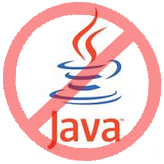I don’t like Java. I have a hard time to explain exactly why I feel this way, but when facing a Java program or just thinking about doing something in Java I feel nothing but panic and dislike. Why is this? I have to admit that due to my general dislike I’ve never done any major Java developments so my feelings are based on occasional hacks and works and not years of punishment.
Java in itself isn’t terrible as a language I think. It is basically C++ with some of the worst parts removed. It is in fact made so simple that nowadays when all people learn Java at school and not much else, we see people getting out lacking clues about much in how computers and low-level stuff actually works.
What I find annoying is that there’s hardly ever any Java-related problem or program that isn’t on top of 22 layers of existing packages – giving me the feeling I’m building a house of cards.
Running a program with the help of a humongous run-time environment isn’t exactly what I like either. It makes the startup-time terrible and it makes the system/memory requirements far bigger than I like. Also, whatever Java-people try to throw at us, everyone that runs Java-based apps on their PCs or in their phones or wherever knows that Java is slow when used in real-life. Period. (Cute quote from Steve Jobs: “Nobody uses Java anymore. It’s this big heavyweight ball and chain.” – not that I believe he’s right in the first part.)
I dislike how everything in Java seems to always be depending on this and that version and this and that doesn’t work in this and that version etc and it’ll all be fixed in the next release. I don’t like how Java programs can’t be built normally with make, I hate the XML-mess called ant, I’m not friends with using GC-only for memory handling and I don’t like how Java is the run-time, the class-library and the language itself all together.
The fact that Java wasn’t at all possible to do completely open source until very recently of course has always kept me reluctant as well, and even if this situation now has changed the marks still live in me.
Of course, I’m never really much of a friend of OO in general as it is commonly used either, as some of the primary premises of OO is quite the opposite of my own beliefs: I don’t believe in hiding what’s is actually done, and most of the OO works, interfaces and inheritance etc are designed and implemented exactly to hide what is actually being done underneath from the users. I want interfaces and APIs that are clear and that makes the user of them understand what the functions do, and I want the actual source code for the functions and libraries to be easy to read and the flow of the code to be easy to follow. OO actually makes following code flow harder.
This of course shows my “on the metal” state of mind and the fact that I never do very high level application development or similar, but the few times I’ve for example looked around in and worked with the Qt source code (C++) it has made me go completely bonkers. I’ll remain working near the hardware and the OS and mostly on resource-restrained systems. I remain with and I really prefer plain C. For scripting situations, I like perl. This way I won’t have to do any Java.






